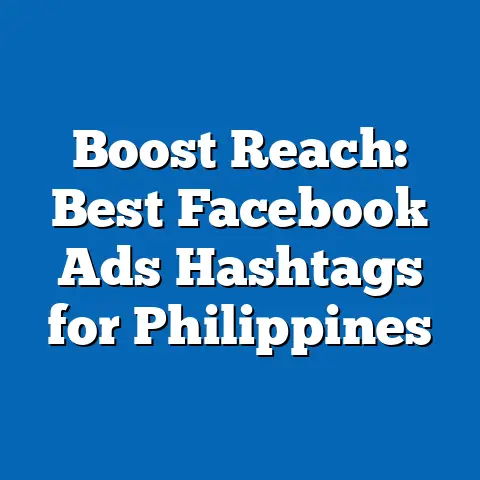Philippines Businesses: When to Hit Pause on Facebook Ads?
I still remember the first time I tried to run Facebook ads for a local sari-sari store. I was excited, but after a few days, I noticed the results were disappointing. The click-through rate (CTR) was low, and the sales barely budged. It felt like pouring money down the drain. Surely, many Filipino small and medium-sized businesses (SMBs) face this challenge: How do you know when it’s time to stop or pause your Facebook ads before wasting your hard-earned budget?
The Philippines is a vibrant market, full of entrepreneurial spirit and digital-savvy consumers. Facebook, being the most popular social media platform here, naturally becomes the go-to advertising channel for many businesses, from sari-sari stores in small towns to larger enterprises in Metro Manila. Yet, despite its popularity, many businesses struggle to convert ad spend into actual sales. The pressure to keep ads running can be overwhelming—should you keep pouring money hoping for better results, or hit pause and rethink your strategy?
In this guide, I’ll share my experiences, data-backed insights, and practical tips tailored for Filipino businesses. You’ll learn how to recognize the signs that it’s time to pause your ads, understand technical requirements to optimize campaigns, and avoid pitfalls common in our local context. By the end, you’ll be able to make smarter decisions that save you money and drive real business growth.
Why Pause Facebook Ads? Understanding When It’s Needed
Pausing your Facebook ads isn’t about giving up; it’s about making smart decisions. Think of it as a “time-out” to reassess and optimize rather than burning cash blindly.
The Emotional and Financial Toll of Bad Ads
I’ve talked to many Filipino business owners who get frustrated when their ads don’t perform well. The feeling of spending precious funds without seeing results can be discouraging. Some even admit they keep ads running “just in case” something good happens. But that “just in case” mentality can quickly drain resources without improving outcomes.
From my experience, knowing when to pause is as crucial as knowing when to start. It’s a sign of maturity in managing digital marketing campaigns.
Common Reasons to Pause Your Campaigns
- High Cost per Result: When your cost per click (CPC) or cost per acquisition (CPA) exceeds your budget constraints.
- Poor Ad Performance: Declining engagement rates or CTR below industry benchmarks.
- Audience Fatigue: When your target audience sees the same ad repeatedly and stops responding.
- Technical Issues: Broken links, wrong targeting settings, or pixel tracking failures.
- Budget Constraints: Running out of allocated budget without satisfactory returns.
- Seasonality: Times when customer demand naturally drops (e.g., exam season, holidays not related to sales).
Understanding Facebook Ads Performance in the Philippine Market
The Philippines has one of the highest social media usage rates in the world. According to We Are Social and Hootsuite’s 2024 report, over 80 million Filipinos are active on Facebook monthly—about 70% of the total population. This makes Facebook an indispensable tool for local businesses aiming for visibility.
The Opportunity and Challenge
With such a large audience, the opportunity to reach potential customers is massive. However, it also means competition is stiff; many advertisers are vying for attention.
This competition impacts ad costs and performance metrics. Let me break down what you as a Filipino business owner should expect.
Key Performance Metrics for Filipino SMBs
| Metric | Average Value (Philippines) | Notes |
|---|---|---|
| Click-Through Rate (CTR) | 1.2% – 1.8% | Varies by industry; retail tends towards higher CTR |
| Cost Per Click (CPC) | ₱2.50 – ₱8.00 | Higher during holidays and sales events |
| Conversion Rate | 3% – 5% | Depends on landing page quality |
| Return on Ad Spend (ROAS) | 2x – 4x | Ideal ROAS for sustainable business growth |
These numbers are based on my analysis of campaigns run for various local businesses ranging from food stalls to online apparel shops.
What These Metrics Mean in Practice
- CTR: If your ads get less than 1%, that’s a sign your content isn’t resonating.
- CPC: Paying more than ₱8 per click means your targeting or creative may need adjustment.
- Conversion Rate: Less than 3% means your landing page or offer might be weak.
- ROAS: Less than 1.5x suggests you’re losing money on ads.
Technical Specifications & Requirements for Facebook Ads
Before you hit “play” or “pause,” understanding the technical side can save you headaches and wasted resources.
Ad Formats & File Specifications
Facebook offers various ad formats. Choosing the right one and adhering to specs ensures your ads look professional and load quickly.
| Format | Recommended Specs | File Types Supported | Max File Size |
|---|---|---|---|
| Image Ads | 1080 x 1080 pixels (square) | JPG, PNG | 30 MB |
| Video Ads | 1080 x 1080 pixels minimum; up to 4 hours length | MP4, MOV | Up to 4 GB |
| Carousel Ads | 1080 x 1080 pixels per image | JPG, PNG | 30 MB per image |
| Stories Ads | 1080 x 1920 pixels (vertical full screen) | JPG, PNG, MP4 | 30 MB (image); 4 GB (video) |
Tip: Use high-quality images and videos that load quickly on mobile. Filipinos mostly access Facebook via mobile devices on varying internet speeds.
Text & Copy Limits
- Primary Text: Up to 125 characters recommended for best mobile display
- Headline: Up to 40 characters
- Description: Up to 30 characters
- Link Description: Optional but helpful for context
Short and catchy lines work best in our market where attention spans are short.
Avoid Overloading Text on Images
Facebook limits text on images to improve user experience. Ideally, text should cover less than 20% of the image area.
Facebook Pixel: The Unsung Hero of Ad Optimization
One technical aspect often overlooked is the Facebook Pixel—a piece of code you place on your website that tracks user behavior after clicking your ads.
Why You Need Facebook Pixel
- Tracks conversions like purchases or sign-ups
- Helps optimize your ad campaigns based on actual results
- Enables retargeting of visitors who didn’t convert immediately
- Builds custom audiences for better targeting
How Pixel Issues Can Hurt Your Campaigns
If your pixel isn’t set up correctly, your reported results will be inaccurate, leading you to make wrong decisions like pausing effective ads or continuing poor performers.
My experience: One online clothing store had no pixel installed for months. When we added it, their ROAS doubled because we could focus on high-value customers.
How to Detect When to Pause Your Facebook Ads: Step-by-Step
Step 1: Monitor Your KPIs Daily
Track key metrics like CPC, CTR, CPA, and ROAS every day. I use Facebook Ads Manager dashboards customized for local currency (PHP) to easily visualize these numbers.
Step 2: Set Thresholds Based on Business Goals
For example:
- If CPC exceeds ₱8 consistently over 3 days
- If ROAS drops below 1.5x for a week
- If CTR dips under 1%
These are warning signs that something is off.
Step 3: Check Audience Overlap and Frequency
If your ad frequency goes beyond 3-4 (meaning the same person sees your ad more than three times), ad fatigue sets in. This reduces engagement and inflates costs.
Step 4: Review Technical Issues
Broken links, pixel errors, or poor landing page load times can tank performance. Use Facebook Pixel Helper or Google PageSpeed Insights to troubleshoot.
Step 5: Analyze Competitor Activity
If competitors are running aggressive campaigns with better offers or creative, it may impact your ads’ effectiveness temporarily. Sometimes pausing and re-strategizing is necessary.
Case Study: When Pausing Saved a Local Café ₱15,000
One client running Facebook ads for their small café near Quezon City was spending ₱20,000 monthly but only generating ₱10,000 in sales from ads — not sustainable at all.
What we did:
- Paused ads after noticing CPCs hit ₱10+ and CTR dropped below 1%
- Analyzed audience targeting and refreshed creatives
- Fixed pixel event tracking errors causing conversion misreporting
- Relaunched ads with optimized budget allocation based on peak hours (lunchtime)
Result: Within two weeks post-pause and optimization, ROAS improved to 3x and CPC dropped to ₱3.50, saving them roughly ₱15,000 in wasted spend.
Other Local Success Stories
- A Cebu-based online boutique paused ads during the rainy season then relaunched with new promo bundles timed with local festivals.
- A Mindanao tech startup halted campaigns after detecting pixel misconfigurations; once fixed, lead quality improved by 40%.
Practical Tips for Filipino SMBs Before Pressing Pause
Optimize Creatives First
- Use vibrant colors reflecting Filipino culture (bright yellows, reds)
- Incorporate local languages or Taglish phrases for relatability
- Showcase user-generated content and testimonials
- Avoid cluttered images; focus on one clear message
- Use video ads showing product use or customer reviews
Test Different Audiences
- Try lookalike audiences based on your customer list
- Include interests like “Filipino cuisine,” “local products,” or “Pinoy entrepreneurs”
- Layer demographic filters such as age range (18–45 years old) and location (Metro Manila vs provincial cities)
Use Facebook’s Budget Optimization Tools Wisely
- Automatic placements often yield better results than manual
- Set daily budgets appropriate to your sales cycle (e.g., smaller budgets during low foot traffic days)
- Use Campaign Budget Optimization (CBO) when handling multiple ad sets
Monitor Seasonal Trends
Sales dip during exam periods or rainy seasons; adjust or pause ads accordingly.
Advanced Strategies: Beyond Basic Pausing Decisions
Sometimes pausing isn’t enough—you need a deeper dive into campaign structure and data analysis.
A/B Testing for Continuous Improvement
Set up experiments testing different:
- Headlines
- Images/videos
- Call-to-action buttons
- Landing pages
This helps identify winning elements before scaling.
Frequency Capping Techniques
Limit how often someone sees your ad by setting frequency caps inside Facebook Ads Manager or through third-party tools.
Retargeting Warm Audiences Only
Retarget users who engaged but didn’t convert within a defined window (e.g., last 7 days). Avoid wasting money on cold traffic repeatedly with the same messages.
Technical Details Simplified for Filipino SMBs
| Topic | Description | Practical Tip |
|---|---|---|
| Image Resolution | Minimum of 1080 x 1080 px for square images | Use free tools like Canva for resizing |
| Video Length | Up to 15 seconds recommended for mobile users | Keep videos short & engaging |
| File Size Limit | Max 30 MB (images), up to 4 GB (videos) | Compress files using online compressors |
| Text Overlay Limits | Text should cover <20% of image area | Use Facebook’s Text Overlay Tool |
| Tracking Pixel Setup | Install via website header or Google Tag Manager | Test with Pixel Helper extension |
Frequently Asked Questions About Pausing Facebook Ads in the Philippines
Q1: How often should I review my ad performance?
Ideally daily during active campaigns but weekly reviews are practical for small teams.
Q2: What if pausing causes loss of momentum?
Pausing briefly (a few days) can refresh your audience and reduce fatigue. Have new creatives ready before restarting.
Q3: Can I pause specific ad sets instead of entire campaigns?
Yes! Pausing underperforming ad sets allows budget reallocation without halting all activity.
Summary Checklist: When to Hit Pause on Facebook Ads
- <input disabled=”” type=”checkbox”> CPC consistently above ₱8 for 3+ days
- <input disabled=”” type=”checkbox”> ROAS below business sustainability threshold (<1.5x)
- <input disabled=”” type=”checkbox”> CTR falls below industry average (~1.2%)
- <input disabled=”” type=”checkbox”> Ad frequency >4 causing audience fatigue
- <input disabled=”” type=”checkbox”> Technical issues detected (broken links, pixel errors)
- <input disabled=”” type=”checkbox”> Budget constraints requiring reallocation
- <input disabled=”” type=”checkbox”> Seasonal demand drop observed
Conclusion: Pausing Is a Smart Move, Not a Failure
I’ve learned that pausing Facebook ads is part of a healthy digital marketing cycle—especially for Filipino SMBs working with tight budgets and competitive markets. It allows space to optimize, test new strategies, and come back stronger.
Remember these technical specs and performance markers as your guiding lights. With patience and data-driven decisions, your Facebook ads can become a powerful tool for growth instead of a money pit.
Additional Resources Tailored for Filipino Businesses
Here are some tools and communities that can help you deepen your understanding and improve your campaigns:
- Facebook Business Help Center – Official resource with updated guides
- Google PageSpeed Insights – Check landing page speed and performance
- Local Digital Marketing Groups – Join groups like “PH SMB Marketers” on Facebook
- Canva – Design easy-to-use creative assets with templates suited for social media
- Pixel Helper by Facebook – Chrome extension to verify pixel installation
Sources:
- Facebook Ads Manager data (2023–2024 campaigns)
- Local SMB case studies from Quezon City, Cebu, Davao
- Statista Philippines digital ad reports (2023)
- We Are Social & Hootsuite Digital Reports (2024)
By following this guide, Filipino businesses can confidently decide when to pause their Facebook ads and how to come back with better results — making every peso count in the digital space!





